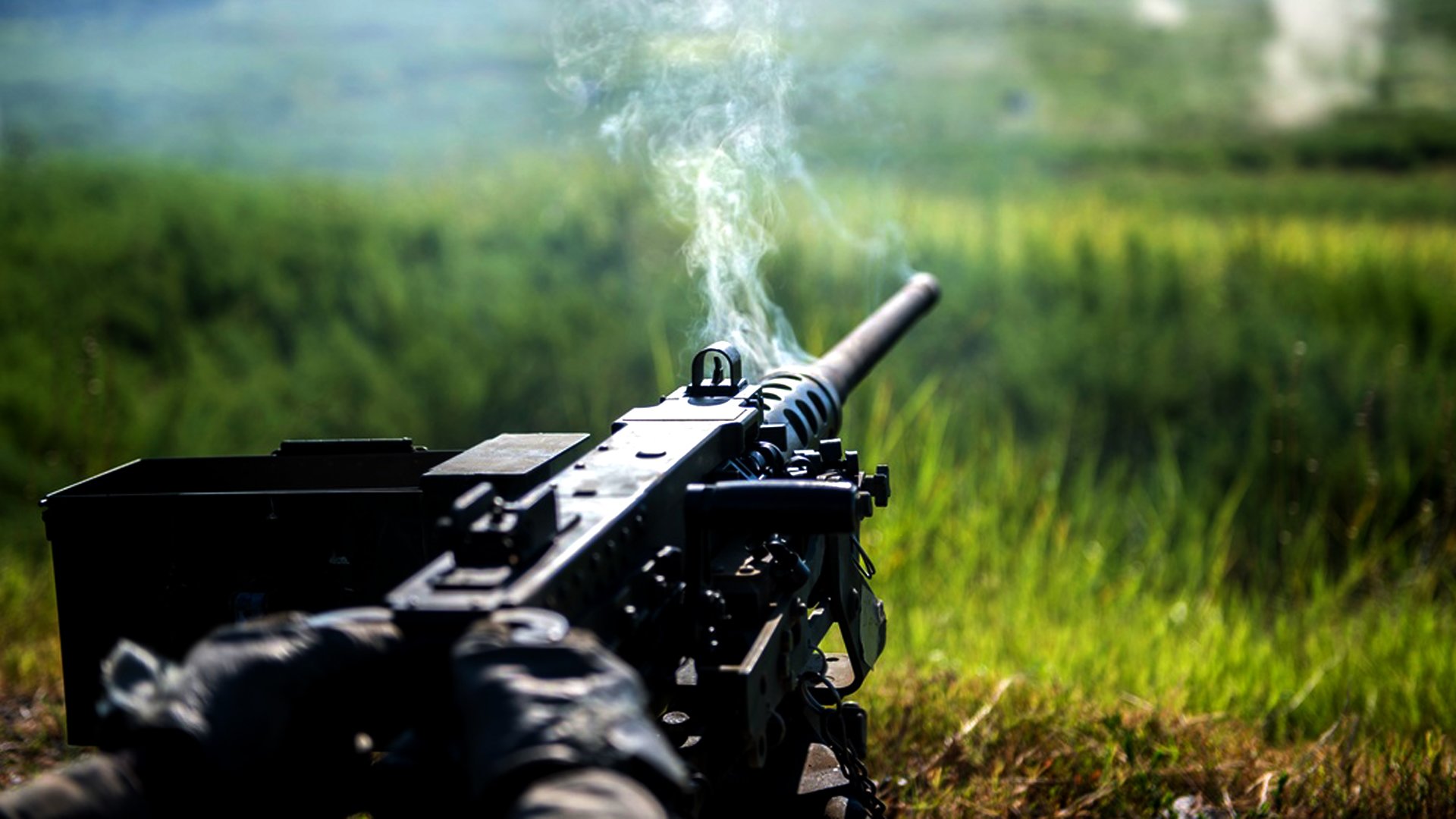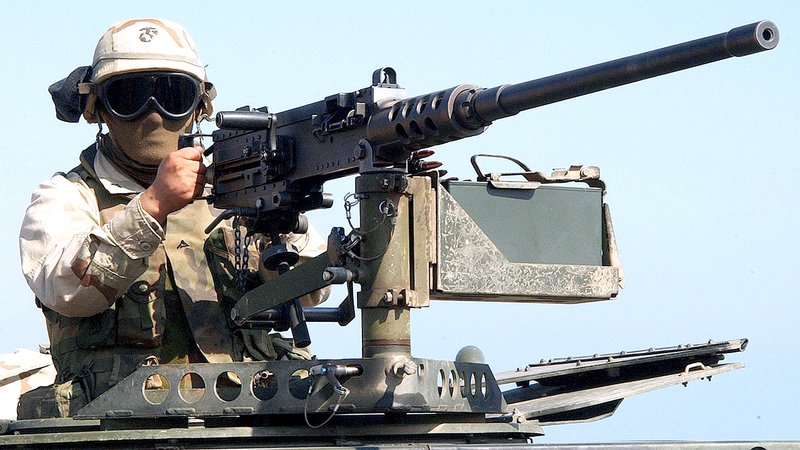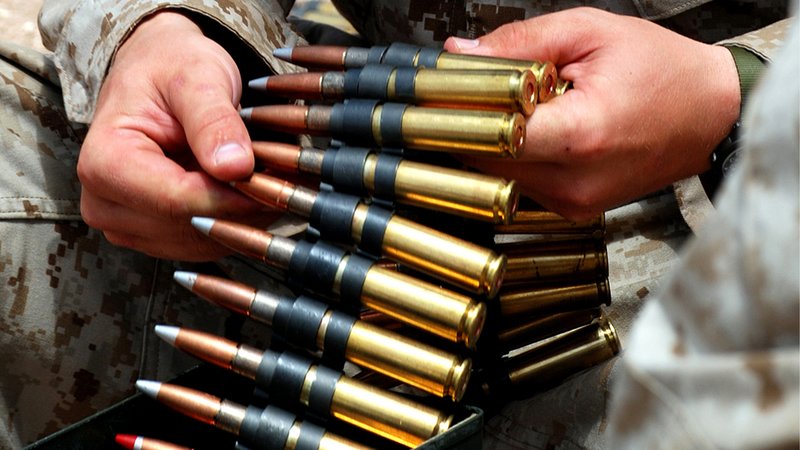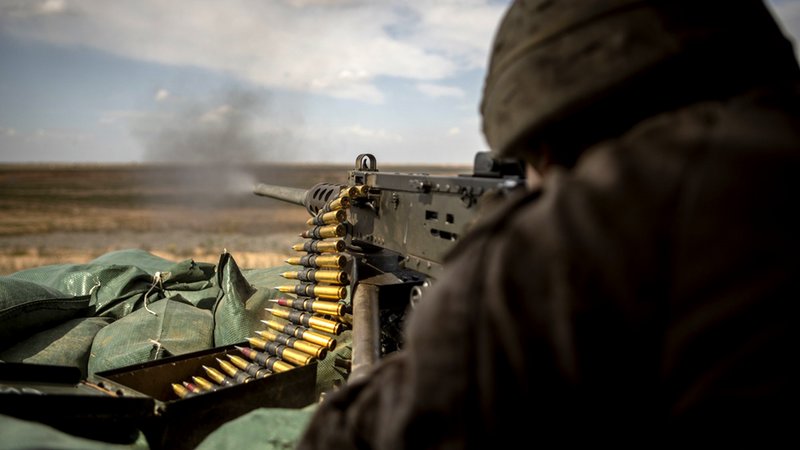
Hot steam rises from the barrel of an M2 Browning .50-caliber machine gun at Fort Chaffee, Ark., Aug. 2, 2015 during Operation River Assault, a bridging training exercise involving Army Engineers and other support elements to create a modular bridge on the water across the Arkansas River. US Army photo by Master Sgt. Michel Sauret.
The M2 Browning .50 caliber machine gun has touched the battlefields of every major American conflict since the Second World War.
Over the decades, the M2 — affectionately known among troops as “Ma Deuce” — has proved to be a highly versatile weapon. It has seen action while affixed to the wings of P-47 Thunderbolts during World War II, installed on riverine boats patrolling the Mekong Delta, and mounted atop Humvees cruising the embattled streets of Mogadishu, Baghdad, and Kabul.
Having first entered the United States military’s arsenal in the 1930s, the Ma Deuce remains to this day an extremely effective and widely used tool of war. But why is that so? How has the M2 Browning managed to outlast all other major American weapon systems? The simple answer: It’s a damn good machine gun.
Related: Silent but Violent: The History of Suppressors
Who Invented the M2 Browning?
John Moses Browning was one of the most prolific weapons inventors of the 19th and 20th centuries. Sometimes described as the “Thomas Edison of Guns,” Browning created some of the world’s most recognizable firearms, including the Model 1911 pistol, the Browning Automatic Rifle, and the M2 Browning.
Born into a Mormon family in Ogden, Utah Territory, in 1855, Browning discovered his passion for gunsmithing as a boy working in his father’s gun shop. By age 14, under his father’s tutelage, Browning had learned the fundamentals of manufacturing and engineering. The first gun he built was a slide rifle fashioned from spare parts that he gave to his brother as birthday present. His interest in the craft only grew from there.
Browning’s big break came in the spring of 1883, when he partnered with the Winchester Repeating Arms Co. Over the next several decades, Browning and Winchester collaborated to create a series of lever-action repeating rifles, pump-action shotguns, and semi-automatic pistols.

Lance Cpl. Paul Rodas assigned to 22nd Weapons Company, 24th Marine Expeditionary Unit (MEU) Special Operations Capable (SOC), mans a .50 caliber machine gun as part of a security force in support of Operation Enduring Freedom. Photo courtesy of Wikimedia Commons.
Browning’s work revolutionized the firearms industry and even the nature of warfare itself. In the 20th century, his patented designs became iconic rifles and machine guns. One example is the Colt-Browning Model 1895, or “Browning Peacemaker,” as it was called during the Spanish-American War. An air-cooled, belt-fed, gas-operated weapon, it was one of the first machine guns the US military carried into battle.
The weapon that made the most impact on the development of the M2 was the M1917 Browning heavy machine gun. The crew-served, belt-fed, water-cooled weapon system — which first used .30-06 ammunition — was ubiquitous in the trenches of Europe during World War I.
Why Was the M2 Browning Invented?
Gen. John J. “Blackjack” Pershing, while serving as commander of the American Expeditionary Forces on the Western Front during WWI, requested the development of a multipurpose heavy machine gun that could be used against ground troops, tanks, and aircraft.
The US Army Ordnance Corps relayed Pershing’s request to Browning with the stipulation that the gun he designed would shoot armor-piercing ammunition capable of traveling at 2,700 feet per second. Such ammunition didn’t exist at the time. Browning asked that the Army find someone else to develop the new ammo so he could focus solely on the actual gun. The Army agreed and contracted Winchester to develop .50-caliber cartridges.

US Marine Corps Cpl. Dane P. Giese counts his ammunition prior to firing the M2 .50 caliber machine gun during Exercise African Lion in Tifnit, Morocco, May 6, 2009. Photo courtesy of Wikimedia Commons.
Browning teamed up with Colt to build prototypes for the new machine gun using the M1917A1’s base design. The weapon would have water-cooled barrels, be fired from a closed bolt, and be recoil-operated, a signature Browning design feature. The prototypes were ready for testing on Nov. 11, 1918, the final day of World War I.
Browning’s creation entered service with the US Army in 1919. From there, the design continued to be modified and refined. After Browning died in 1926, Colt rectified certain flaws the company had identified in his design and in 1933 unveiled the M2 Browning machine gun.
Related: Carlos Hathcock Was the ‘American Sniper’ of the Vietnam War
In What Conflicts Has the M2 Browning Seen Action?
American troops have wielded the M2 in battle since at least the 1940s. The list of conflicts the machine gun has seen includes World War II, the Korean War, the Vietnam War, Operation Urgent Fury in Grenada, Operation Just Cause in Panama, the Gulf War, the Battle of Mogadishu, and the Global War on Terror.
In most, if not all, of those conflicts the M2 was used to great effect. On Dec. 7, 1941, for example, while Japanese planes strafed American battleships at Pearl Harbor, Messman 2nd Class Doris Miller defended the USS West Virginia with an M2 Browning machine gun. He held off the enemy with anti-aircraft fire long enough for his comrades to evacuate the ship. As a result of his actions, he became the first Black American service member to receive the Navy Cross.
The M2 also saw action in the air on that fateful day. Army Air Corps pilots 2nd Lt. George S. Welch and 2nd Lt. Kenneth Taylor raced into the sky with their Curtiss P-40 Tomahawk fighters armed with fixed Browning machine guns. The two pilots downed seven enemy aircraft during the battle.

U.S. Marine Corps Lance Cpl. Brogen Hohnholt, a mortarman with Weapons Company, 3rd Battalion, 4th Marines, attached to Special Purpose Marine Air Ground Task Force Crisis Response-Central Command, fires a M2 .50 Cal. machine gun during live-fire unknown distance range in Southwest Asia, March 17, 2019. US Marine Corps photo by Sgt. Justin Huffty.
In the Vietnam War, legendary Marine Corps sniper Carlos Hathcock killed an enemy soldier at a distance of 2,460 yards. The nearly mile-and-a-half-long shot was not from his rifle but an M2 Browning machine gun modified with a special rifle mount built by US Navy Seabees. The M2 also added extra firepower to helicopters, riverine patrol boats, and gun trucks during the war.
M2s were also prominent during the Battle of Mogadishu in 1993. The battle, portrayed in the book and film Black Hawk Down, saw Army Rangers and other US special operations forces using M2s mounted atop their vehicles to fight their way through the streets of Mogadishu. The machine guns’ .50-cal rounds smacked enemy fighters taking cover behind concrete walls, brick structures, and the doors of improvised fighting vehicles.
Read Next: ‘Guns of John Moses Browning’ Explores Life and Legacy of Legendary Gunmaker

Matt Fratus is a history staff writer for Coffee or Die. He prides himself on uncovering the most fascinating tales of history by sharing them through any means of engaging storytelling. He writes for his micro-blog @LateNightHistory on Instagram, where he shares the story behind the image. He is also the host of the Late Night History podcast. When not writing about history, Matt enjoys volunteering for One More Wave and rooting for Boston sports teams.
BRCC and Bad Moon Print Press team up for an exclusive, limited-edition T-shirt design!
BRCC partners with Team Room Design for an exclusive T-shirt release!
Thirty Seconds Out has partnered with BRCC for an exclusive shirt design invoking the God of Winter.
Lucas O'Hara of Grizzly Forge has teamed up with BRCC for a badass, exclusive Shirt Club T-shirt design featuring his most popular knife and tiomahawk.
Coffee or Die sits down with one of the graphic designers behind Black Rifle Coffee's signature look and vibe.
Biden will award the Medal of Honor to a Vietnam War Army helicopter pilot who risked his life to save a reconnaissance team from almost certain death.
Ever wonder how much Jack Mandaville would f*ck sh*t up if he went back in time? The American Revolution didn't even see him coming.
A nearly 200-year-old West Point time capsule that at first appeared to yield little more than dust contains hidden treasure, the US Military Academy said.












